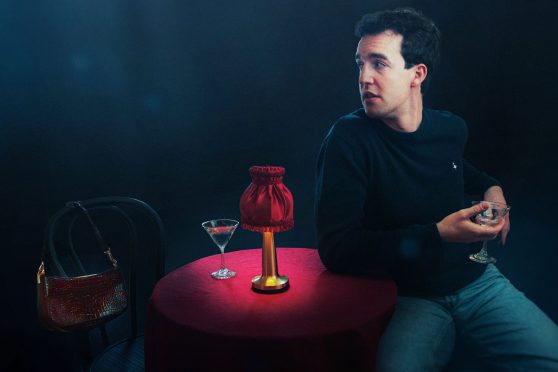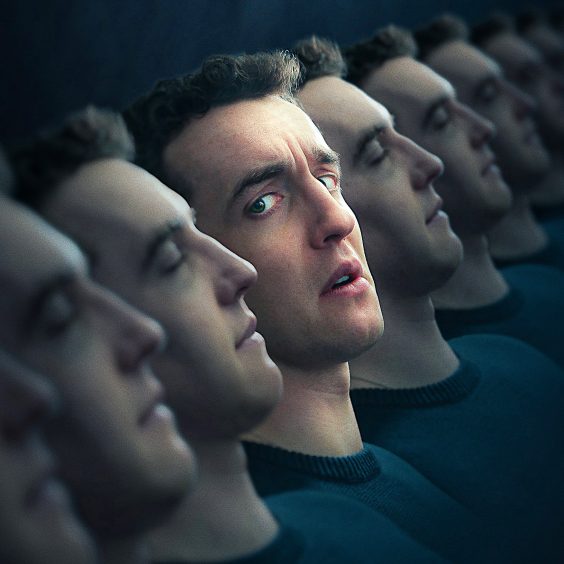
Written and performed by Peter McCormick, Beyond Krapp is a dark comedy that follows Cormac, a dead man, in the black void of purgatory as he’s taunted by snippets of his own funeral.
Exploring the existential reckoning of ego and the brutal landscape of unrequited love, the Edinburgh Fringe play is inspired by Samuel Beckett’s absurdist works, Krapp’s Last Tape and Eh Joe.
Here, Peter answers our festival Q&A…
How are you feeling ahead of this year’s festival?
Like a newborn giraffe. I know we have a great show, but I’m still tripping over my feet and trying to walk before I crawl. This is my first Fringe and I’m carrying all the nerves, jitters and clumsiness that comes with that. I’ve had so much help and support to get here, so I want to do all those people proud while also just taking what I can from the experience, learning as a performer and seeing some great shows.
What’s your show all about?
Beyond Krapp is a black comedy about ego and unrequited love. Cormac is in Purgatory, bitter about his death and the funeral he was given, which was a far cry from the hedonistic orgy he wanted. He is haunted by a female voice echoing in the void, and we witness the last stand of his ego as he makes the case for his Ex to join him in the afterlife.
It’s based on works by Samuel Beckett – how inspiring / terrifying did you find them?
It’s certainly inspired by Beckett. Beyond Krapp began when my writing mentor, Meghan Tyler, asked what scared me. I read Krapp’s Last Tape at university because it was the shortest play on the reading list, and annoyingly discovered that it articulated my worst fears – fears about failure, regret, and failing to understand love. The tragedy and fragility of masculinity and ego was so perfectly captured, and I was never going to be brave enough to try replicate that. But the play stuck with me and inspired me to write about a man my own age who has utterly failed to understand love, and particularly failed to respect and appreciate the women in his life.
What do you hope audiences take away from the show?
I want the audience to leave feeling emotionally raw, full of laughter, and very aware of their capacity to love and be loved. I want them to feel the tingle you get on the surface of your skin when you are really present in a moment. I also want them to consider the people in their lives and how they treat them. I don’t mean that in some preachy way – this is not a preachy play. But I hope they leave feeling a little more self-aware, having spent an hour watching a young man with immense ego but no true self-awareness.
You studied and now live and work in Glasgow, how has that been?
Living in Glasgow is like wearing a nappy: it inspires me to produce as much crap as possible, and supports me as I do. This is a truly amazing city that completely defied my expectations. I assumed I’d move after drama school, but I graduated a year ago and couldn’t work out why I’d want to leave. I am surrounded by people who want to create and play and help, and I can’t ever express how lucky I feel to have them in my life. Someone once said I struck them more as an ‘Edinburgh type of person’, which I later realised was the worst insult they could give me. But aside from my own pretentiousness, this city is devoid of ego and glowing with creativity.
If you were in charge of the Fringe, what changes would you make?
I’d overhaul the advertising system. I wasn’t so naïve as to think the Fringe was a cheap, accessible endeavour (though it should be…), but the advertising costs are beyond any level of reason. I used to visit the Fringe and assume every show had put up posters around the city – now I know those posters only represent a fraction of what’s actually on, because no small company with only a few grand behind them (and that’s still a lot of money) can possibly afford to get their name out there at current prices.
What’s your favourite spot to visit in Edinburgh?
One of the endless cafes that make me feel comfortable enough to work on a script. Then when the brain fog sets in, a walk in the graveyards. They’re quite calming and humbling spaces. Perfect for when I need to simultaneously feel encouraged to make the most of my work and also remember that it’s really so insignificant in the grander scheme.
How have your previous experiences of the festival been – either as a visitor or performer?
I’m bringing Beyond Krapp to the Fringe because of how much I loved going as a visitor and wanted to be a part of it myself. I went with my mum and sister for the last two years and loved how I got to see new sides of their personalities as we dragged each other to different shows and emerged with radically different opinions. In 2022, I saw Mabel Thomas’ one-woman show ‘Sugar’ at The Space. It was bright, funny, gut-punching, uncomfortable and so brilliantly done. Seeing how a drama school grad could put themselves out there and write and produce their own work was incredibly inspiring and encouraging and gave me the urge to give it a go myself.
What item is essential to survive a month at the Fringe?
Other than toilet paper, my Airpods. That’s a very knobby answer, but I like listening to RTÉ radio when I’m walking to the theatre. It helps me to disconnect, makes me feel at home, and reminds me that there are a million more important things going on, and this is just one moment in time.
Who else are you looking forward to seeing at the festival?
The best thing about the build-up has been meeting so many writers and hearing about some brilliant show. Serious Theatre for Serious People at Gilded Balloon is going to be a big hit this year. It’s about two young actors prepared to do whatever it takes to win their success. The creators, Charlotte Anne-Tilley (Almost Adult) and Mabel Thomas (Sugar) play two young actors prepared to do whatever it takes to succeed, and both performers are immense talents. My show looks at death through a Beckett lens, so I’m excited to see how The Sound of the Space Between uses sound and technology to look at it in an immersive live performance. And Hamstrung at the Pleasance will look at death from a Shakespearian angle, and it’s going to be a hilarious show. Make the Bed will be heavy watch, but well worth it as it’s full of beauty and hope. And to give me a laugh afterwards, I’ll be seeing Molly Geddes and Emma Grey as Edinburgh’s naughtiest nuns in Bad Habit at The Space.
What question would you ask other Fringe performers in a Q&A – and why?
I’d ask them what their goals for the Fringe are, because it’s something I keep coming back to when I get anxious or carries away. Everyone is here for a different reason: some are ticking it off a bucket list, some want to meet creatives and network, some think their show will be the next big Netflix hit. But realistically, it’s just an experience for me. A chance to share my work, become a better writer and actor, improve my stamina and lay down some roots as a creative in Scotland. And my mother wanted me to do it.
Beyond Krapp, Pleasance Courtyard (Cellar), 31 July–26 Aug (not13&19), 13:45

Enjoy the convenience of having The Sunday Post delivered as a digital ePaper straight to your smartphone, tablet or computer.
Subscribe for only £5.49 a month and enjoy all the benefits of the printed paper as a digital replica.
Subscribe